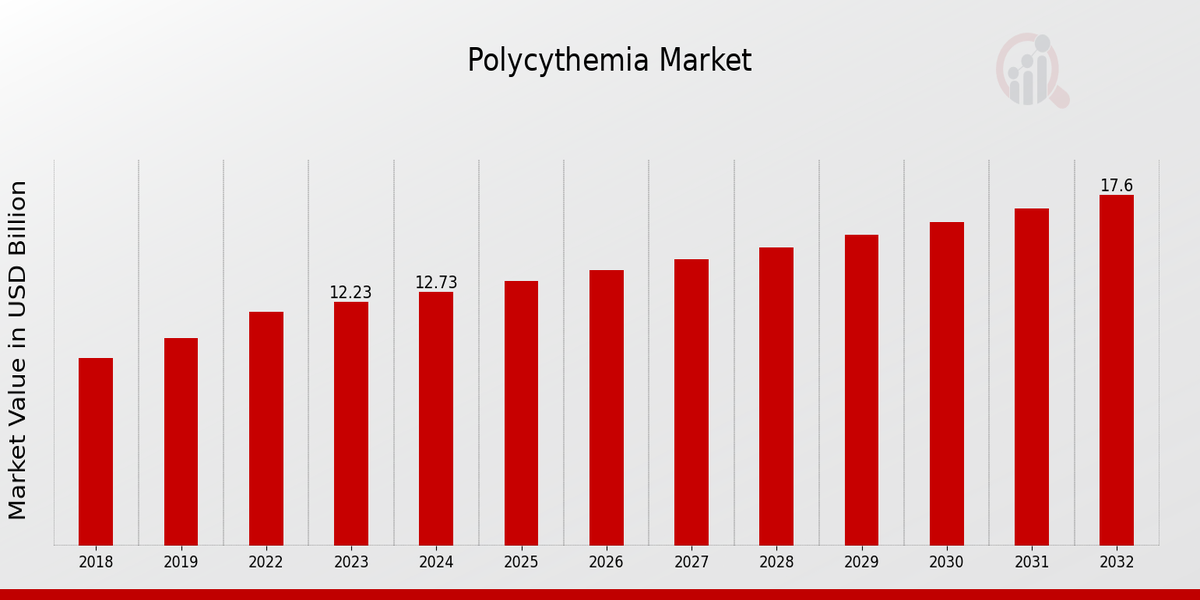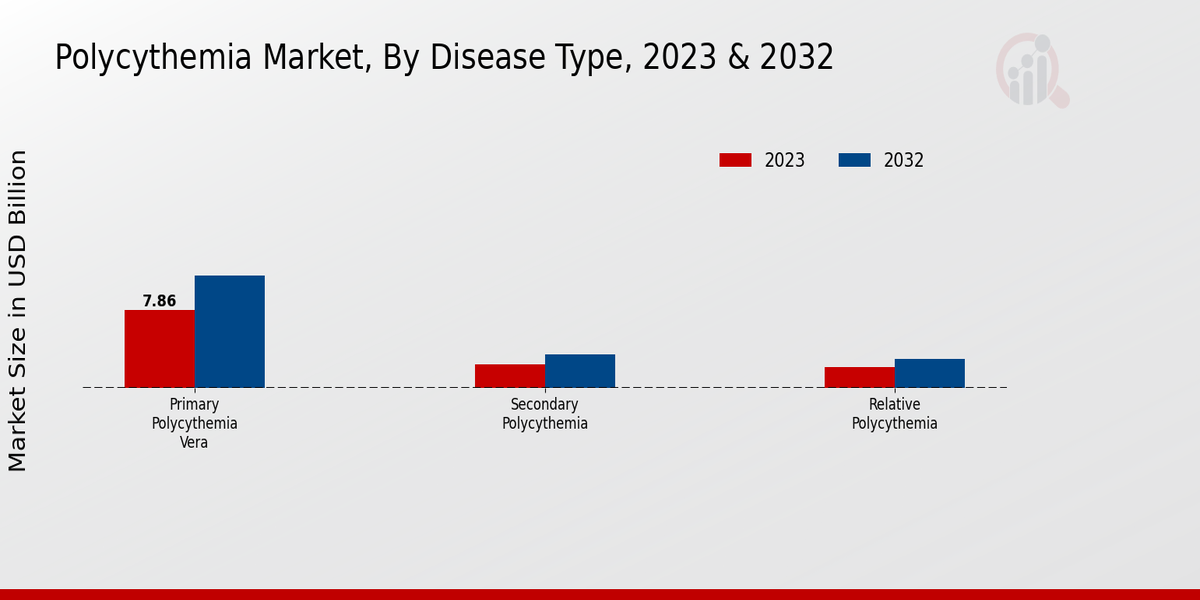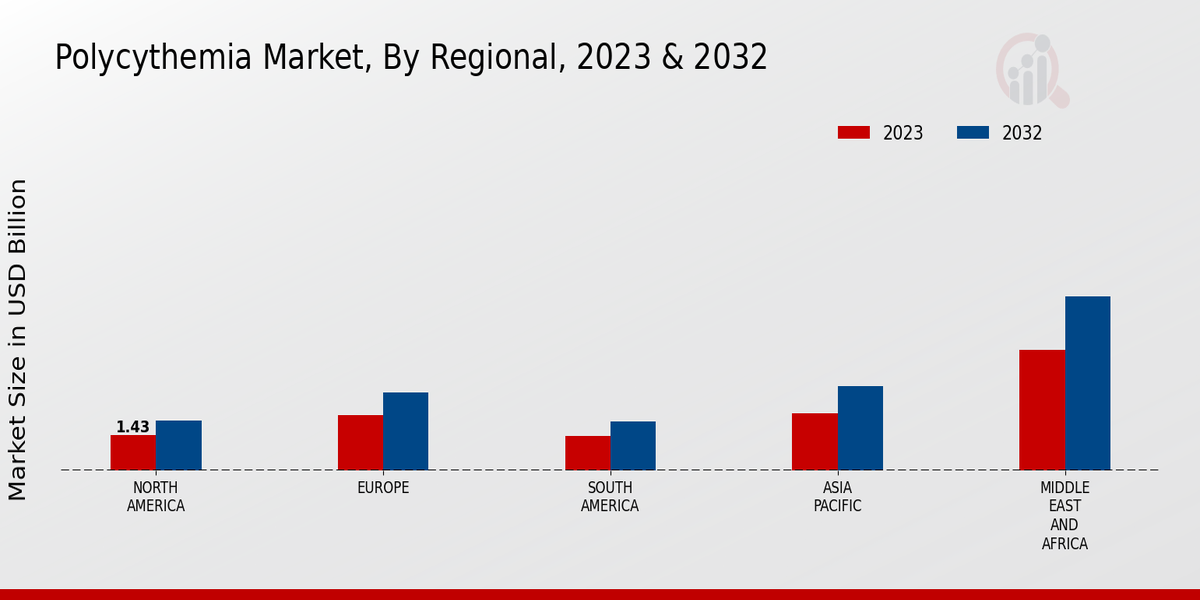Polycythemia Market Overview
As per MRFR analysis, the Polycythemia Market Size was estimated at 1.54 (USD Billion) in 2023. The Polycythemia Market Industry is expected to grow from 1.63 (USD Billion) in 2024 to 2.32 (USD Billion) by 2032. The Market CAGR (growth rate) is expected to be around 3.99% during the forecast period (2024 - 2032).
Key Polycythemia Market Trends Highlighted
The increasing prevalence of myeloproliferative neoplasms (MPNs), including polycythemia vera (PV), is a significant driver of the Polycythemia Market. Advances in diagnostics, such as molecular testing, have improved the accuracy and speed of diagnosis, leading to earlier detection and treatment initiation.
Opportunities for growth in the polycythemia market include the development of targeted therapies, such as JAK2 inhibitors, which have demonstrated superior efficacy and tolerability compared to conventional treatments. Additionally, the exploration of novel therapeutic approaches, such as gene therapy and stem cell transplantation, holds promise for improving outcomes in patients with polycythaemia.
Recent market trends include a growing focus on personalized medicine, with the development of therapies tailored to individual patient characteristics. The increasing use of real-world evidence is also shaping the market, providing insights into the effectiveness and safety of treatments in real-world settings.

Source: Primary Research, Secondary Research, MRFR Database and Analyst Review
Polycythemia Market Drivers
Rise in Prevalence of Blood Disorders
The increasing prevalence of blood disorders, such as polycythemia vera and essential thrombocythemia, is one of the key factors propelling the growth of the Polycythemia Market. PV is a rare blood cancer that causes the body to produce too many red blood cells, while ET is a condition that causes the body to produce too many platelets.
Both conditions can result in severe complications, including blood clots, heart attacks, and strokes. As a result, the incidence of these disorders is anticipated to surge, creating a growing demand for polycythemia vera treatment and driving market expansion throughout the projected period.
Improved Diagnosis and Treatment Through Technology
Progress in diagnostic methods and new treatments are growing the Polycythemia Market. Molecular diagnostics now allow faster, more accurate polycythemia diagnoses, leading to earlier treatment. Targeted therapies, like JAK inhibitors, have greatly improved patient treatment results. These technological improvements should continue to expand the market.
Increased Public Knowledge and Patient Support
Greater awareness of the disease and its treatments is also driving the global polycythemia market. Patient advocacy groups and non-governmental organizations are actively educating patients and the public. This better understanding aids in timely diagnosis and treatment, which expands the market and its reach.
Polycythemia Market Segment Insights
Polycythemia Market Disease Type Insights
The Polycythemia Market is segmented by Disease Type into Primary Polycythemia Vera, Secondary Polycythemia, and Relative Polycythemia. Primary Polycythemia Vera is a rare blood cancer that develops when the body produces too many red blood cells.
It is the most common form of polycythemia, accounting for about 95% of cases. The symptoms of Primary Polycythemia Vera may include fatigue, weakness, headache, dizziness, shortness of breath, and itching.
Secondary Polycythemia is a condition in which the body produces too many red blood cells in response to another disease or condition, such as lung disease, heart disease, or kidney disease.The symptoms of Secondary Polycythemia are similar to those of Primary Polycythemia Vera but may also include the signs and symptoms of the underlying disease.
Relative Polycythemia is a rare form of condition in which the body possesses a normal number of red blood cells, but the blood is thicker than normal. This can happen due to dehydration or other conditions that decrease the amount of liquid in the blood.
The growth of the market is ascribed to the increasing prevalence of polycythemia, the rising demand for the introduction of new and effective treatments, and the developing awareness about the disease.
The market for Primary Polycythemia Vera is expected to increase at the highest CAGR during the forecast period. It is accounted for by the increasing incidence of the disease and the presentation of new and highly effective treatments. The market for Secondary Polycythemia is also expected to grow at a significant CAGR, considering the growing prevalence of other diseases that cause Secondary Polycythemia.
The market for Relative Polycythemia is predicted to grow at a comparatively low CAGR during the forecast period. It is due to the developing awareness of the condition and the presentation of new and effective treatments.

Source: Primary Research, Secondary Research, MRFR Database and Analyst Review
Polycythemia Market Treatment Type Insights
The Polycythemia Market is segmented into Phlebotomy, Cytoreductive Therapy, and Stem Cell Transplant based on Treatment Type. Phlebotomy accounted for the largest share of the market in 2023, and it is projected to continue to dominate the market during the forecast period.
The growth of this segment can be attributed to the increasing prevalence of polycythemia vera, a type of blood cancer that causes an increase in red blood cell production.
Cytoreductive Therapy is expected to witness significant growth during the forecast period, owing to the rising adoption of targeted therapies for the treatment of polycythemia vera. Stem Cell Transplant is a promising treatment option for patients with high-risk polycythemia vera, and it is expected to gain traction in the coming years.
Polycythemia Market End User Insights
The Polycythemia Market is segmented by end user into hospitals, clinics, and research institutes. Hospitals are the primary end users, accounting for the largest share of the market. This is because hospitals have the necessary infrastructure and expertise to diagnose and treat polycythemia. Clinics are the second largest end-user, followed by research institutes.
The market for polycythemia treatment in clinics is expected to grow at a CAGR of 3.87% from 2024 to 2032, reaching a value of 16.5 billion USD by 2032. The market for polycythemia treatment in research institutes is expected to grow at a CAGR of 3.61% from 2024 to 2032, reaching a value of 15.4 billion USD by 2032.
Polycythemia Market Regional Insights
The Polycythemia Market segmentation, based on region, is expected to generate a revenue of USD 12.23 billion in 2023, which is projected to grow to USD 17.6 billion by 2032, exhibiting a CAGR of 4.13%. This growth can be attributed to factors such as the rising prevalence of chronic diseases, the increasing geriatric population, and technological advancements in the healthcare industry.
North America region is likely to hold the largest market share due to the high adoption of advanced healthcare technologies and the presence of well-established healthcare infrastructure.
Europe is another significant market, driven by government initiatives to improve healthcare facilities and increasing demand for personalized medicine. APAC region is anticipated to witness substantial growth due to rising healthcare expenditure, increasing population, and growing awareness about Polycythemia.
South America and MEA regions are expected to show steady growth due to the expanding healthcare sector and increasing investments in healthcare infrastructure.

Source: Primary Research, Secondary Research, MRFR Database and Analyst Review
Polycythemia Market Key Players And Competitive Insights
Major players in Polycythemia Market are continuously developing and launching new products to expand their market share and cater to the evolving needs of patients. Strategic partnerships, acquisitions, and collaborations are common strategies adopted by industry leaders to strengthen their position in the market.
Leading Polycythemia Market players are investing heavily in research and development to improve the efficacy and safety of their products. This has led to the development of innovative therapies and treatment approaches, further fuelling Polycythaemia Market development.
The Polycythemia Market is characterized by intense competition among established players and emerging entrants. To stay competitive, companies are focusing on product differentiation, cost optimization, and expanding their geographical reach.
A leading company in the Polycythemia Market industry is Novartis, which holds a significant market share.
The company's strong brand recognition, extensive distribution network, and commitment to research and development have contributed to its success. Novartis offers a range of innovative therapies for Polycythemia, including Jakavi and Tasigna.
These products have demonstrated high efficacy and tolerability, making them popular choices among healthcare professionals and patients.
Novartis's strong presence in emerging markets and its focus on patient support programs further enhance its position in the Polycythemia Market.Another prominent competitor in the Polycythemia Market is Incyte.
The company has gained recognition for its breakthrough therapy, Jakafi. Jakafi has received approval for the treatment of Polycythemia Vera and Myelofibrosis, providing patients with a well-tolerated and effective treatment option. Incyte's commitment to research and development has led to the expansion of its pipeline, with several promising candidates in late-stage clinical development.
The company's focus on patient advocacy and its collaboration with leading healthcare institutions have contributed to its strong reputation in the Polycythemia Market.
Key Companies in the Polycythemia Market Include
- Mylan N.V.
- Karyopharm Therapeutics Inc.
- Agios Pharmaceuticals Inc.
- Bristol Myers Squibb
- Roche (Genentech)
- Teva Pharmaceutical Industries Ltd.
- Lupin Limit
- Incyte Corporation
- Reddy's Laboratories
- Glenmark
- Pfizer
- Sun Pharmaceutical Industries Ltd.
- Novartis
- Merck , Inc.
- Cipla
Polycythemia Market Industry Developments
The Polycythemia Market is anticipated to reach a valuation of USD 17.6 billion by 2032, expanding at a CAGR of 4.13% from 2024 to 2032. The rising prevalence of chronic conditions such as cardiovascular diseases, respiratory ailments, and cancer is a primary driver of market growth.
Recent advancements in diagnostic techniques, including molecular profiling and genetic testing, have improved disease detection and monitoring. The development of novel therapies, including JAK inhibitors and immunomodulatory drugs, is further expected to drive market growth. Key market players are focusing on strategic collaborations and acquisitions to strengthen their product portfolios and expand their geographical reach.
Polycythemia Market Segmentation Insights
Polycythemia Market Disease Type Outlook
- Primary Polycythemia Vera
- Secondary Polycythemia
- Relative Polycythemia
Polycythemia Market Treatment Type Outlook
- Phlebotomy
- Cytoreductive Therapy
- Stem Cell Transplant
Polycythemia Market End User Outlook
- Hospitals
- Clinics
- Research Institutes
Polycythemia Market Regional Outlook
- North America
- Europe
- South America
- Asia Pacific
- Middle East and Africa
| Report Attribute/Metric |
Details |
| Market Size 2023 |
1.54 (USD Billion) |
| Market Size 2024 |
1.63(USD Billion) |
| Market Size 2032 |
2.32(USD Billion) |
| Compound Annual Growth Rate (CAGR) |
3.99% (2024 - 2032) |
| Report Coverage |
Revenue Forecast, Competitive Landscape, Growth Factors, and Trends |
| Base Year |
2023 |
| Market Forecast Period |
2024 - 2032 |
| Historical Data |
2019 - 2023 |
| Market Forecast Units |
USD Billion |
| Key Companies Profiled |
Mylan N.V., Karyopharm Therapeutics Inc., Agios Pharmaceuticals Inc., Bristol Myers Squibb, Roche (Genentech), Teva Pharmaceutical Industries Ltd., Lupin Limit, Incyte Corporation, Dr. Reddy's Laboratories, Glenmark, Pfizer, Sun Pharmaceutical Industries Ltd., Novartis, Merck Co., Inc., Cipla |
| Segments Covered |
Disease Type, Treatment Type, End User, Regional |
| Key Market Opportunities |
Rising prevalence of polycythemia Emerging targeted therapies Growing awareness of disease Advances in diagnostics Technological advancements |
| Key Market Dynamics |
Rising prevalence of chronic diseases Growing geriatric population Technological advancements in diagnostics and treatment Increasing demand for personalized medicine Expanding reimbursement policies |
| Countries Covered |
North America, Europe, APAC, South America, MEA |
Frequently Asked Questions (FAQ) :
The Polycythemia Market is projected to reach a valuation of 12.23 billion USD in 2023.
The Polycythemia Market is projected to grow at a CAGR of 4.13% from 2024 to 2032.
The Polycythemia Market is projected to reach a valuation of 17.6 billion USD by 2032.
North America is expected to hold the largest market share in the Polycythemia Market in 2023.
The primary polycythemia segment is expected to hold the largest market share in the Polycythemia Market in 2023.
Some of the key competitors in the Polycythemia Market include Novartis AG, Bristol-Myers Squibb Company, and Pfizer Inc.
The increasing prevalence of polycythemia vera and the growing demand for novel therapies are key factors driving the growth of the Polycythemia Market.
The high cost of treatment and the lack of awareness about polycythemia are key challenges faced by the Polycythemia Market.
The development of new therapies and the increasing adoption of personalized medicine are key opportunities for the Polycythemia Market.
The increasing use of JAK inhibitors and the growing adoption of telemedicine are key trends in the Polycythemia Market.

















